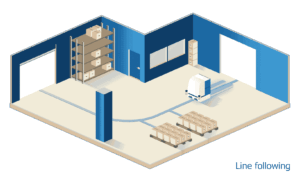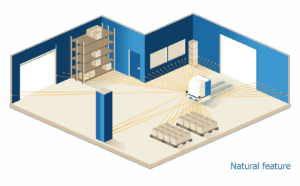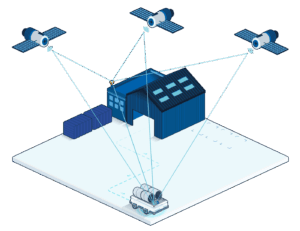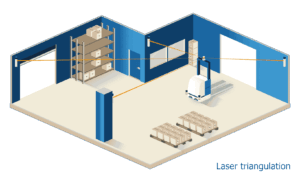Over the past decade, automated guided vehicles (AGVs) have evolved from rigid, single-purpose machines into intelligent, adaptable systems capable of managing complex material flows. Fueled by Industry 4.0 integration and rapid advancements in navigation technologies, this transformation has enabled AGVs to operate with exceptional precision, flexibility, and scalability in modern factory settings.
From fixed paths to adaptive intelligence
Today, a variety of AGV navigation technologies are available to suit different operating environments, project requirements, and budgets.
Technologies that rely on physical infrastructure, such as magnetic tapes, embedded wires, or reflective markers for laser guidance, remain well-suited for highly structured settings and repetitive tasks, like those found on assembly lines. In contrast, recent advancements in laser triangulation, natural feature navigation (SLAM – Simultaneous Localization and Mapping), and LiDAR have dramatically enhanced AGV autonomy. These innovations support infrastructure-free navigation, enabling AGVs to detect and adapt to obstacles in real time and operate efficiently in dynamic, unstructured environments.
Key technological advancements
- Laser guidance: Originally limited to indoor environments, laser navigation systems now integrate with hybrid technologies, such as differential GPS (dGPS), to enable smooth transitions between indoor and outdoor operations.
- Natural navigation: Technologies like SLAM and LiDAR allow AGVs to create real-time 3D maps of their surroundings, enabling dynamic rerouting and collision avoidance. This approach minimizes reliance on physical infrastructure, reducing installation costs and making AGVs viable in unstructured or constantly changing environments.
- Hybrid systems: By combining magnetic markers, GPS, and inertial sensors, hybrid navigation systems deliver optimal performance in mixed-use settings. For instance, AGVs in outdoor logistics yards may use GPS for wide-area coverage, while indoor operations benefit from the precision of magnetic guidance.
- AI and IoT integration: Modern AGVs are increasingly equipped with artificial intelligence and IoT connectivity, enabling real-time analytics, predictive maintenance, and workflow optimization. For instance, onboard sensors can monitor battery health and traffic flow, helping reduce downtime and increase operational efficiency.
AGV navigation has evolved from rigid, infrastructure-dependent systems into intelligent, adaptive solutions. By integrating laser precision, SLAM-based flexibility, and hybrid scalability, today’s AGVs are transforming material handling across industries.
EVALUATION AND ANALYSIS
Choosing the most suitable AGV navigation technology requires a careful balance of multiple factors, including vehicle cost, installation complexity, adaptability, scalability, modification costs, accuracy, and long-term reliability.
The following analysis outlines the key strengths and limitations of various navigation methods — inductive, optical, natural, GPS-based, tag/transponder, and laser triangulation — to support informed decision-making and optimize workflows for heavy material handling.
1. INDUCTIVE (WIRE) GUIDANCE
How it works: AGVs navigate by following wires embedded in the floor, using radio signals for communication.
Indoor performance:
- Advantages:
- Unaffected by dust, smoke, or lighting variations, making it ideal for industrial environments.
- High accuracy (±5 mm), well-suited for heavy, repetitive tasks, such as transporting loads over 200 tons.
- Limitations:
- Rigid routing; any path modifications require rewiring and significant infrastructure changes.
- Limited scalability for multi-AGV operations due to fixed-path constraints.
Outdoor use:
- Generally not recommended, as embedded wires are susceptible to weather conditions and damage from heavy outdoor traffic.
Cost analysis:
- Initial investment: Moderate.
- Modification costs: High (due to floor rewiring and potential operational downtime).
Suitability for multi-AGV fleets:
- Most effective in structured, high-volume environments with minimal need for route adjustments.
2. OPTICAL GUIDANCE (LINE/TAPE FOLLOWING)
How it works: AGVs follow visual cues such as painted lines, magnetic tape, or adhesive markers placed on the floor.
Indoor performance:
- Advantages:
- Low initial investment.
- Easy and quick installation without the need for floor embedding.
- Limitations:
- Susceptible to wear and tear; requires frequent maintenance and replacement of tape or paint.
- Moderate accuracy (±10 mm), which can be negatively impacted by dust, dirt, or floor debris.
Outdoor use:
- Generally unsuitable, as lines and markers are vulnerable to weather exposure and surface damage.
Cost analysis:
- Initial investment: Low.
- Modification costs: High (manual realignment, replacement materials, and potential downtime).
Suitability for multi-AGV fleets:
- Best for small fleets; fixed-path navigation increases the risk of congestion in high-traffic scenarios.
3. NATURAL NAVIGATION (SLAM/LIDAR)
How it works: AGVs navigate by mapping their environment in real time using LiDAR sensors, cameras, or SLAM algorithms.
Indoor/outdoor performance:
- Advantages:
- No need for physical infrastructure, significantly reducing installation time and costs.
- Capable of dynamic obstacle detection, avoidance, and autonomous rerouting.
- Easily scalable for multi-AGV fleets in complex, changing environments such as modern warehouses.
- Limitations:
- Moderate positioning accuracy (±10 mm).
Cost analysis:
- Initial investment: Moderate.
- Modification costs: Low (routes can be updated through software without physical changes).
Suitability for multi-AGV fleets:
- Highly effective for adaptive, high-mobility fleets operating in environments that require flexibility and frequent layout changes.
4. GPS (dGPS Hybrid)
How it works: Combines differential GPS (dGPS) with inertial sensors to enable navigation in large outdoor environments.
Outdoor performance:
- Advantages:
- Extensive coverage across wide areas such as ports, container terminals, and logistics yards.
- Low modification costs thanks to the use of virtual paths.
- Limitations:
- Lower positional accuracy (±100 mm).
- Signal reliability can degrade in covered, urban, or high-interference environments.
- Generally ineffective for indoor use due to signal blockage.
Cost analysis:
- Initial investment: High (due to advanced sensor integration and system calibration).
- Modification costs: Low.
Suitability for multi-AGV fleets:
- Well-suited for managing large-scale AGV fleets in outdoor settings with relatively simple, repetitive routes.
5. LASER TRIANGULATION
How it works: AGVs navigate by scanning fixed reflectors placed on ceilings or walls using onboard laser sensors to calculate their precise position through triangulation.
Indoor performance:
- Advantages:
- High positioning accuracy (±5 mm).
- Enables centralized traffic control, improving coordination and safety in multi-AGV systems.
- Limitations:
- Requires extensive infrastructure – installation of reflectors is both time-consuming and expensive.
- Performance may degrade if reflectors are obstructed or dirty.
Outdoor use:
- Viable only in semi-sheltered environments such as covered loading docks, due to sensitivity to weather and visibility conditions.
Cost analysis:
- Initial investment: High.
- Modification costs: Moderate (involves both software updates and physical adjustments to reflector placements).
Suitability for multi-AGV fleets:
- Ideal for high-precision indoor applications, such as automated forklift systems.
TECHNOLOGY COMPARISON TABLE
| Factor | Inductive | Optical | Natural | GPS | Laser |
| Indoor Accuracy | Good | Moderate | Moderate | Poor | Good |
| Outdoor Viability | Moderate | Poor | Good | High | Poor |
| Initial Cost | $$$ | $ | $ | $$ | $$$ |
| Modification Cost | $$$ | $$ | $ | $ | $$ |
| Multi-AGV Compatibility | Low | Low | High | Medium | High |
AGV navigation: the right solution for every environment
To achieve optimal results, consider a hybrid approach: use inductive or laser systems for high-precision applications, natural navigation for flexibility and adaptability, and GPS/tags for scalable outdoor operations. Whenever possible, prioritize technologies that allow for software-based upgrades, such as natural navigation, to future-proof your systems.
Morello’s project design teams are ready to support you in selecting the most appropriate navigation solution and engineering the corresponding hardware to meet your operational goals.
Based on your plant layout and performance requirements, Morello’s engineers will recommend the most suitable technology, or combination of technologies, after evaluating key factors such as accuracy, reliability, environmental conditions, and budget constraints.





